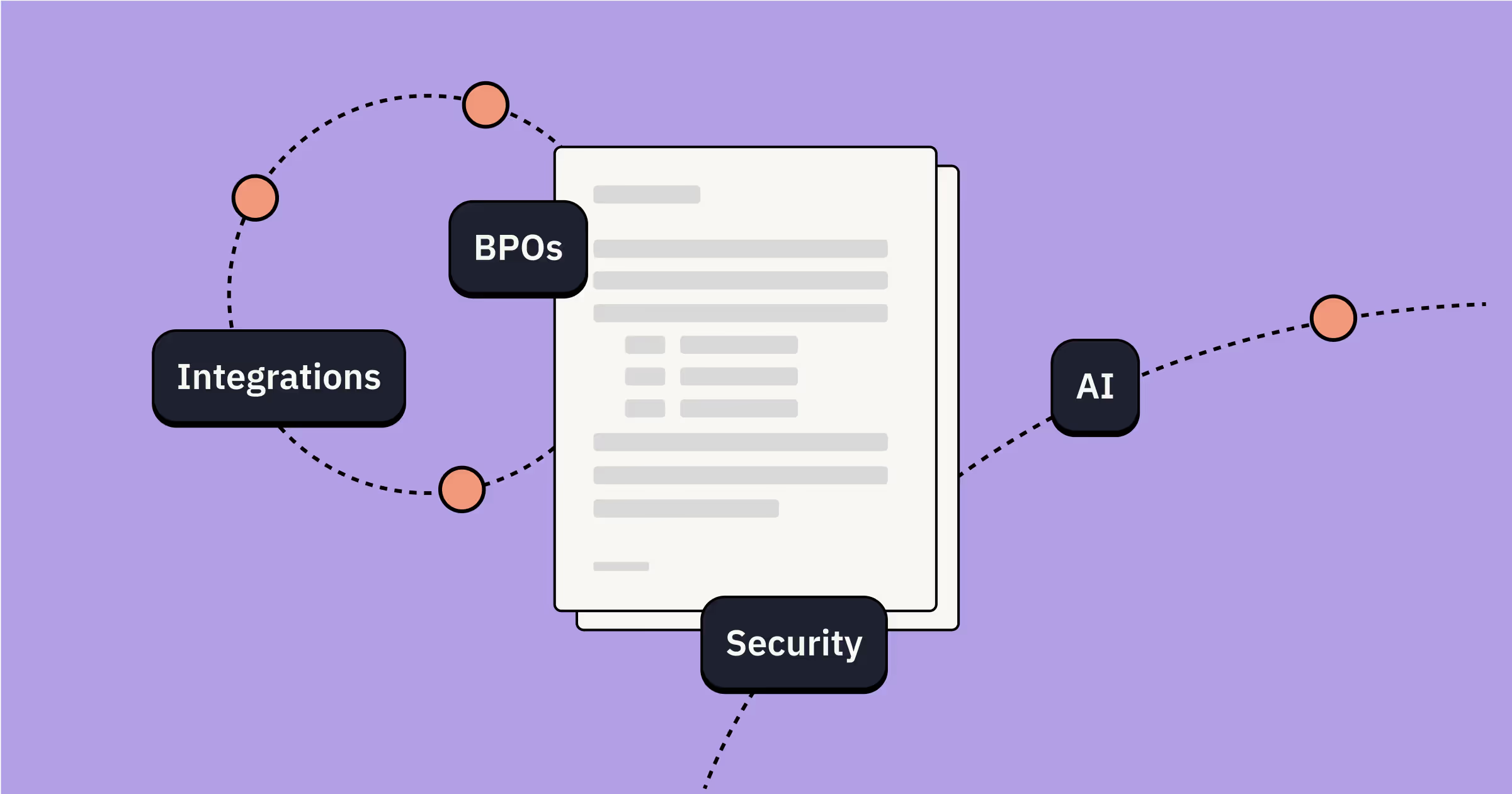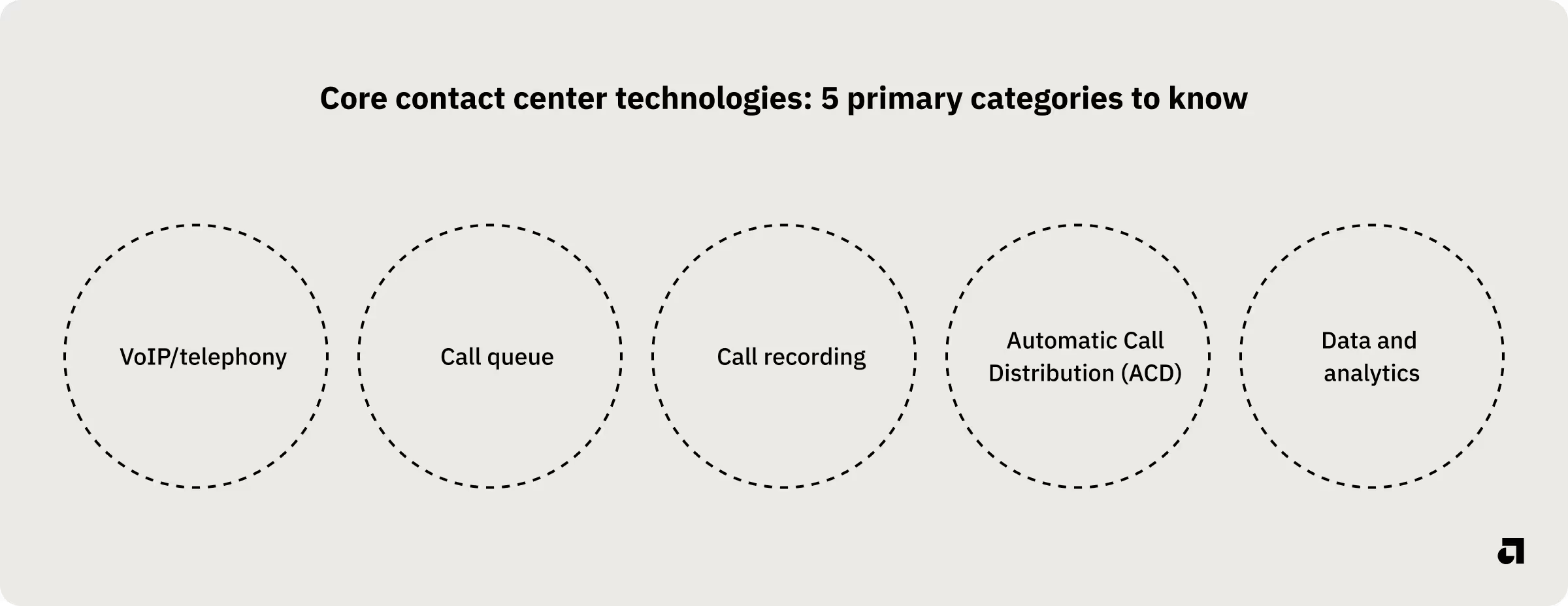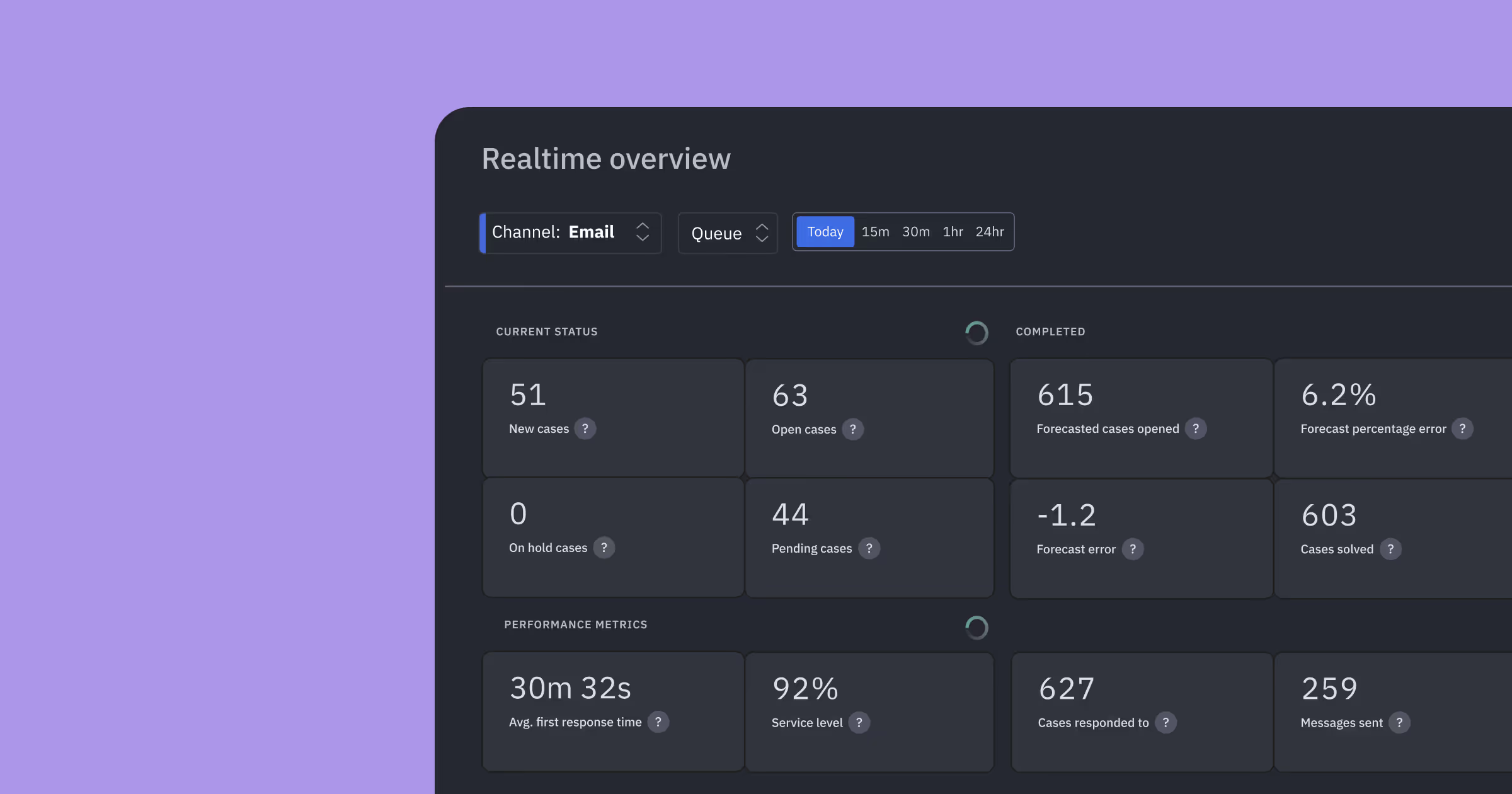The full guide to contact center technologies
See demo
When customers reach out to your business, they have one clear expectation from you: a response. However, as basic as that premise seems on the surface, it can be surprisingly complex to fulfill.
How do you prioritize and organize customer inquiries and outreach? How do you determine which agent answers which question? How do you ensure you have adequate staffing to get those questions in a reasonable amount of time? How do you keep things from slipping through the cracks?
It’s all the responsibility of a modern contact center — and it highlights the importance of contact center technology for helping support teams meet customer expectations without spinning their wheels.
Whether you’ve already tested the waters of different contact center technologies or are looking around for the first time, this guide covers what you need to know:
- What is a contact center?
- What is contact center technology?
- Core contact center technologies: 5 primary categories to know
- 6 must-know benefits of contact center technologies
- Eye to the future: Emerging trends in contact center technologies
- What contact center technologies are right for your company?
What is a contact center?
A contact center is a centralized team, department, or function within a company that manages all inbound and outbound communications with the company’s customers, clients, and other stakeholders. This happens using various communication channels like phone calls, emails, web chats, social media, and SMS.
Customer support is usually the first and only function people think of when they imagine a contact center (and that’s a big and important use case). However, contact centers play diverse roles in organizations and can optimize and handle a variety of important tasks, including:
- Customer support: Handling customer inquiries, troubleshooting customer issues, addressing customer needs, and generally providing assistance.
- Sales: Managing sales calls (both inbound and outbound calls), upselling, cross-selling, and converting leads into customers.
- Marketing: Conducting market research, running telemarketing campaigns, and gathering customer feedback.
- Technical support: Offering specialized assistance for technical products or services, including troubleshooting, installation guidance, and post-purchase support.
- Order management: Processing orders, tracking shipments, and handling returns or exchanges.
- Billing and payments: Addressing billing inquiries, processing payments, and managing account-related issues.
- Retention and loyalty programs: Engaging with customers to reduce churn, offering loyalty rewards, and managing customer satisfaction initiatives.
- Surveys and feedback collection: Conducting customer satisfaction surveys, gathering feedback, and analyzing customer data to improve services.
- Emergency response: Providing immediate support and handling urgent customer communication during crises.
- Human resources support: Assisting with employee questions, payroll issues, and HR-related tasks.
- Vendor and partner management: Coordinating with external partners or vendors, managing service levels, and ensuring seamless collaboration.
Put simply, while customer calls and support are a core focus of most contact center agents, it’s only the tip of the iceberg on what a contact center can handle.
What is contact center technology?
A painter needs a paintbrush, a woodworker needs a hammer, and a contact center needs the right technology. Contact center technology is the broad term for any tools and platforms a company uses to manage, streamline, and optimize interactions across various communication channels.
You might also hear contact center technology called contact center software or call center software. They all mean the same thing: the technology tools a contact center team relies on to do their jobs well.
Much like any other type of technology, contact center solutions have changed a lot over the past decade or more. For example, modern call center technology has experienced major changes to:
Process
What used to be managed with a clunky phone system and a jumbled spreadsheet can now be handled by modern solutions that not only handle call distribution but also more complex tasks like forecasting and sentiment analysis.
Additionally, contact centers no longer rely on on-premises systems but on cloud-based solutions that offer more opportunities to use artificial intelligence (AI), automation, advanced analytics, and other features that weren’t available on legacy systems.
Communication channels
Previously, contact centers placed a heavy focus on voice interactions. But today, phone calls are just a slice of the pie.
53% of customers say they prefer to exchange text messages with a business. And 68% of customers use social media to get information about new products and services (with 30% of users expecting an immediate response from agents).
Contact centers have had to move away from a one-channel approach and transition to an omnichannel contact center model, where people can engage using whatever communication method they choose (voice, email, chat, social media, and more) and still have a consistent and seamlessly connected experience.
Why do these advancements matter? Two words: customer experience. When 85% of executives say improving the customer experience is a top or significant business priority, the right contact center technology can help teams improve the customer journey and perception with:
- Shorter wait times: Workforce management is a category of contact center technology that helps contact center managers in forecasting call volume and ensuring more accurate staffing levels. That means shorter wait times for incoming calls.
- Helpful and accurate support: When technology provides detailed analytics, insights from previous interactions, and automatic call routing to the most appropriate agent, customers also benefit from better, targeted support for their needs — without getting bounced around.
And while call center technology is good news for customers, it’s good news for your team of human agents too. The right solutions offer streamlined workflows, adequate staffing, and information at their fingertips, all of which help reduce agent burnout and frustration.
Core contact center technologies: 5 primary categories to know
Contact center technology is the term used for any type of solution or platform a contact center uses, but several distinct categories of technology fall under that umbrella. These include:

- VoIP/telephony: Voice over Internet Protocol (VoIP) is considered the foundational technology for modern contact centers. With this method, voice communication happens via your internet connection rather than traditional phone lines. It allows for more flexible, scalable, and cost-effective communication, especially when handling large volumes of customer calls.
- Call queue: This feature organizes incoming calls by placing them on hold until the next available (or most appropriate) agent can assist. Well-organized queuing ensures customer interactions are managed efficiently by reducing the likelihood of missed calls or long wait times.
- Automatic Call Distribution (ACD): This technology works hand-in-hand with call queues by automatically routing incoming calls to the most appropriate or readily available agent. This ensures that customer queries are handled by the right person as quickly as possible.
- Call recording: Considered a standard feature in contact centers, call recording allows agents to record customer interactions to review and reference later. Recording interactions is helpful for training agents, ensuring quality control, and resolving customer disputes.
- Data and analytics: Modern contact centers don’t just need tools — they need information. Advanced data and analytics tools provide real-time insights into agent performance metrics, which helps monitor agent efficiency, customer satisfaction, and the success of the entire contact center.
That’s not a comprehensive list. Contact center technology can also include a customer relationship management (CRM) platform for storing customer information, a knowledge base to provide customers with self-service options, and any other tools the team uses to efficiently and effectively handle communication.
6 must-know benefits of contact center technologies
In this day and age, most people understand the role of technology in improving speed, simplicity, and accuracy.
But it’s not enough to just have contact center technology. When 86% of companies admit that outdated technology and inflexible systems hinder their ability to respond to customer needs, you need to have the right technology in place.
When you do, your team (and entire company) can benefit from:
- Increased agent productivity: Contact center technologies streamline workflows and reduce manual tasks, allow agents to handle their work more efficiently, and lead to higher productivity and smarter use of your available resources.
- Better customer experiences: From queue management to CRM integration to data analytics, businesses can provide faster and more personalized service that increases customer satisfaction and loyalty.
- Reduced costs: Cloud-based contact center solutions and VoIP reduce or eliminate the need for expensive, on-premises infrastructure (and maintenance of that infrastructure). Plus, features like forecasting and automatic call routing optimize your resource allocation, which lowers operational costs even more.
- Enhanced compliance and security: With call recording and the right data management tools, businesses in regulated industries can ensure compliance while also protecting sensitive customer information.
- More operational agility: You can’t take quick action without information. Advanced analytics and reporting tools give you the real-time insights you need to make swift decisions and respond to changing customer needs and market conditions.
- Supported business growth: As your business grows, the needs of your contact center grow too. Contact center technologies can scale to support increased call volumes and entirely new channels. That means you can maintain quality and consistency, even as your organization expands.
Eye to the future: Emerging trends in contact center technologies
Modern contact centers have come a long way from switchboards or rotary phones. Here are three major call center technology trends that are shaping the future of contact centers.
Artificial intelligence
You probably suspected that AI would appear at the top of the list. As McKinsey explains, “The contact center emerged as an early use case for generative AI” and Gartner predicts that, by 2025, a whopping 80% of customer service and support organizations will apply generative AI technology in some way.
Here are just a few of the ways that contact centers are using AI to boost productivity and performance:
- Conversational AI: Using a combination of machine learning and natural language processing (NLP), conversational AI uses advanced chatbots and virtual assistants to handle text or voice inquiries in a human-like manner.
- Automation: Many contact centers also use AI to automate routine tasks like transcription, call routing, and agent scheduling.
- Predictive analytics: In some cases, AI can analyze huge data sets to anticipate customers’ needs and behaviors. This allows agents to detect issues before they occur and provide more personalized and proactive support.
These advancements are impacting the internal operations of the contact center as well as customer support roles in general. While many contact center agents understandably feel hesitant about how AI will impact their jobs, there seems to be good news ahead. AI solutions can provide contact center reps with more time to focus on complex problem-solving and better career development opportunities.
Chatbots
Chatbots are a specific application of artificial intelligence in the contact center, using natural language processing to simulate human conversation through voice (using interactive voice response or IVR) or text. Chatbots have seen an impressive uptick in recent years, with an estimated 76% of contact centers currently using chatbots.
Chatbots can be surprisingly intelligent but, in most cases, are still best suited for basic and routine customer FAQs — like updating payment information or tracking a shipment. Even so, we’ll likely see the capabilities (and adoption) of chatbots increase as AI continues to expand.
Think customers will complain when their inbound call or text is answered by an AI-powered chatbot instead of a real, human agent? You might be surprised. Customers are largely satisfied with their interactions with chatbots, with 80% of customers saying they’ve had positive experiences with the technology.
And even more surprising, in one recent study, customers indicated that there are certain times when they prefer a chatbot over a real representative, such as when they’re buying potentially embarrassing products.
Omnichannel customer support
An omnichannel experience — which delivers a seamless customer experience across multiple communication channels — is no longer a competitive differentiator. According to recent research, it’s now a baseline customer expectation. A whopping 86% of consumers say they expect conversations with agents to move seamlessly between channels.
Customers not only expect the opportunity to reach your support team via any platform, but also for their customer information to stick with them across channels. For example, the details they provided in previous support phone calls should be available to the agent helping them via live chat.
Modern contact center solutions need to deliver on this expectation by providing agents a holistic view of all support channels, rather than keeping channels siloed.
What contact center technologies are right for your company?
As you start evaluating which call center technology is right for you, you’ll quickly realize you have plenty of options. A search on G2 for “call center” yields more than 1,200 results.
While choices can be encouraging, they can also be overwhelming when trying to figure out which solutions and tools are the right match for your business. Here are some criteria to consider to make your most informed choice:
- Business needs: It’s smart to approach your search for contact center technology similarly to any other tool: identify your problem or need first, and then look for a solution that fixes that. Whether you need help improving your workforce management or automatically routing callers to agents, staying focused on your needs will help you find software that feels like a benefit rather than a burden.
- Business size and future plans: Do you need a solution that supports a small enterprise with high call volumes? Or one that’s more tailored to the needs of small businesses? Additionally, what are your plans for the future? If you intend to grow, look for solutions that can scale with your business.
- Integrations: From your CRM to your IVR systems, your team already has certain software that they use frequently. Consider those non-negotiable tools as you explore your options so you can choose contact center technology that integrates seamlessly with them.
- Budget and cost efficiency: A solution might be perfect, but you still need to be able to afford it. Work with your company’s decision-makers ahead of time to iron out a budget for your contact center technology. That number will help you quickly narrow down your options. Keep in mind that, as your business and team grow, the cost of your call center software will likely increase too.
- Compliance and security: If your industry has specific rules for data protection and regulatory compliance, confirm the technology is a match for those standards.
- Ease of use and implementation: You want your contact center technology to improve your workflows — not disrupt them. Sign up for a demo, read user reviews, and talk with customer support to get a solid grasp on how easy the software is to implement and how much training is typically required.
- Customer support: Even if the software is easy to adopt, it’s normal to have some questions. Ask thoughtful questions about their customer support processes and practices to get an idea of how quickly you can expect an answer when you’re stuck.
Optimize your contact center operations with Assembled
A successful contact center needs the right technology — and it also needs the right people. Assembled helps you check the box on both.
With Assembled’s workforce management software, you have visibility into your staffing and agent performance to improve productivity, boost operational efficiency, and deliver an exceptional customer experience across all your communication channels. Assembled offers:
- Automated scheduling to easily schedule teams at scale
- Real-time monitoring to identify issues and make intraday adjustments
- Metrics, reports, and actionable insights to help you make smarter business decisions
- Generative AI to guide your human agents or automate resolution of support tickets
Remember, customers have a clear expectation when they reach out to your brand or business: a prompt and helpful response. With Assembled, you’ll put the right people in the right place to meet (and even exceed) your customers’ expectations.
Ready to transform your contact center? Get started today.





